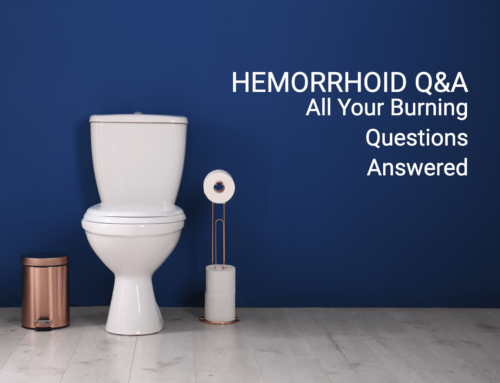The most common reason for people to need a J-pouch is due to ulcerative colitis, one of the two types of inflammatory bowel disease. Ulcerative colitis is a chronic condition of the large intestine (your colon), where the colon lining becomes inflamed and develops tiny open sores, or ulcers, that produce pus and mucous. The combination of ulceration and inflammation can cause frequent trips to the bathroom and abdominal discomfort. The other type of inflammatory bowel disease is Crohn’s disease, and this condition is not curable by surgery.
The J-pouch, a minimally invasive laparoscopic procedure, is a way for people who have been living with the pain and discomfort of this chronic condition to find relief from their symptoms, have better control of their bowel movements, and it does not require a permanent ileostomy. J-pouches also are used for familial adenomatous polyposis (FAP) and occasionally, colon and rectal cancer. When the colon (large intestine) and rectum are removed (due to chronic colitis, cancer or other colorectal diseases), another method must be devised for solid waste to exit the body.
Surgically creating a “J” shaped reservoir, or J-pouch, out of an individual’s own small bowel (small intestine) is an alternate way for you to store and pass stool. This eliminates the need for a permanent external bag (ostomy). The procedure is most often performed in two stages, usually performed two or three months apart.
“For people who have indeterminate colitis (where it’s difficult to make a colitis diagnosis), the decision to have a J pouch surgery is more involved,” says Shauna Lorenzo-Rivero, M.D., colorectal surgeon at University Surgical Associates.“If you have the J-pouch surgery and it is discovered you have Crohn’s disease, it’s less likely that the pouch will be successful in the long term.”
Steps to the J-pouch Procedure
Because most people would prefer to go to the bathroom through their anus rather than into an ileostomy bag, the J-pouch provides an option that is similar to how the body is originally constructed.
Step One
The first part of a J-pouch procedure is a total abdominal proctocolectomy and ileal pouch anal anastomosis (IPAA). In this procedure, the entire colon and rectum are removed from a person’s body, and a reservoir is created from the distal small bowel (called the ileum). It’s then joined to the anal canal.
“The neorectum is created by taking the end of the small bowel and turning it on itself. I open the area so it’s twice the size of the lumen or small bowel and attach it to the anus,” says Dr. Lorenzo. “It’s not as good as what you were born with, but it allows a person to go to the bathroom 4-6 times a day, not every hour.”
Step Two
Next, a temporary ileostomy is made. An ileostomy is a surgically created opening between the small bowel and the skin of the abdomen through which stool and gas are passed. This temporary ileostomy diverts the stool, protecting the reservoir (pouch)while it heals.
The second surgery “takes down” or removes the ileostomy and reconnects the bowel. The pouch now becomes functional so that waste passes into the pouch, where it is stored. When an “urge” is felt, the stool can be passed through the anus, out of the body. In most cases, the second surgery can be done at the ileostomy site without re-opening the first incision. The skin at the former ileostomy site is usually left to close on its own.
Life After Surgery
After the second surgery and a person starts passing stool through the anus, stools are frequent and liquid. There may be some urgency and leakage of stool that generally improve over time as the anal sphincter muscles strengthen and the pouch begins to function normally.
Patients can help this transition process by avoiding foods that cause diarrhea, gas and anal irritation. Stools become thicker as the small intestine absorbs more water, and medications to decrease bowel activity and bulk-forming agents may be prescribed to thicken the stool.
“After the surgery to remove the colon and rectum and the J-pouch is formed, most people don’t require the immunosuppressive medications they once needed to control their ulcerative colitis,” says Dr. Lorenzo.
When is the Right Time for J-Pouch?
By the time most people arrive at a surgeon’s office, they’ve usually been under the care of a gastroenterologist (a physician who treats diseases of the GI tract) for some time. That often means taking several medications and trying different combinations of medicines to control symptoms. When those options are exhausted and symptoms are out of control, surgery is often the next step.
“When I discuss removing a person’s colon, I explain that the colon’s only function is to absorb water and that it’s possible to live without it,” says Dr. Lorenzo. “The time to make the choice for surgery is before the symptoms increase to a degree where the procedure is an emergency and not a planned decision.”
Have questions about the J-Pouch? We welcome the opportunity to talk to you. If now is the right time for you to talk to a surgeon about J-pouch, please call (423) 267-0466 and we can refer you to a colorectal surgeon.







The article provides informative insights about the J-pouch procedure for managing conditions like ulcerative colitis. It explains how the surgery can offer relief, improved bowel control, and a better quality of life for patients.